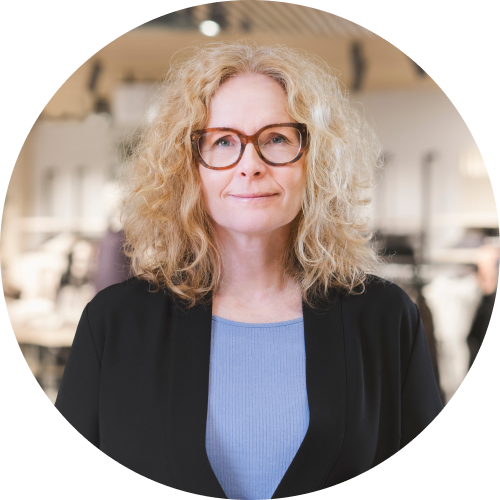
Industry experts predict 2025
We asked three leading industry professionals for their predictions for 2025. Elisabeth Peregi has been the CEO of the Kappahl Group since 2019, previously holding leadership roles at Lindex and Scandic Hotels. Anders Borg, an economist and former Swedish Minister of Finance, is an advisor to several Swedish companies and recently published the book Vart är vi på väg? Helena Waker is the CEO of Stockholm Fashion District and Trade Partners Sweden.
Elisabeth Peregi, CEO, Kappahl Group
What major trends and challenges do you think will define the fashion industry in 2025?
“I believe 2025 will mark the breakthrough of circular business models – it’s been simmering for a while, and now is the time. I also think we’ll see higher demands from customers regarding how companies act on sustainability issues, especially in terms of social responsibility, such as in production countries. At the same time, the trend of ultra-fast fashion will continue, impacting competition.”
Considering the economic climate, what strategies are most effective for navigating rising production costs and increasing consumer demands for value?
“It’s essential to be clear about what sets your market offering apart. Why should the customer choose us? Reviewing the supply chain – the number of suppliers, including subcontractors – and reassessing pricing and lead times are critical. To achieve this, you need to understand your customers and anticipate their future behaviours – being relevant remains crucial.”
Kappahl has launched several sustainability initiatives. How do you see sustainability as a key to success in 2025, and what specific steps should fashion companies take to meet both consumer and regulatory demands?
“Many industry players have different approaches to sustainability, and unfortunately, the whole industry gets a bad reputation when a few actors fall short and act irresponsibly. Fashion companies need to clearly communicate what kind of product the customer is buying, how it’s designed and manufactured, and how they can care for their garments for a longer lifespan. Traceability plays a significant role here. Both our own data and independent research show that consumers value traceability information, which influences purchasing decisions. In short: fashion companies need to help customers create a sustainable wardrobe for the long term, produced responsibly – making a difference for both people and the planet.
“We also see growing interest in moving away from fossil-based raw materials in textiles. I think it’s essential to offer more natural materials like wool and linen, even for everyday wear.”
The digital transformation continues to reshape the fashion industry. What technologies or digital solutions are crucial for enhancing customer experience and building loyalty in an increasingly digital world?
“Anything that simplifies the customer experience – ordering, returns, payments – essentially everything that makes the interaction and transaction faster, easier, and smoother. But without making the customer feel surveilled.”
Given the changing landscape for physical retail, how do you think the role of stores will evolve by 2025? What innovations can help retailers remain relevant and attract consumers to physical stores?
“I believe the strength and role of the store will entirely depend on the customer interaction and service promise. The store is an extension of the brand; it’s where the company and customer meet, and this needs to be genuine and personal. Innovations that save time for both the customer and the company, combined with a focus on customer interaction and service, make all the difference.”
How do you think changing consumer behaviours, particularly among younger generations, will impact how fashion brands and retailers should act moving forward?
“We need to understand different generations and how they behave. It’s important to understand and engage with your target audience and remain open to the new behaviours that emerge. I think it’s essential to evolve and test new approaches.”
What are your top three pieces of advice for fashion brands and retailers preparing for 2025?
“1: Nurture your relationships – with customers, employees, business partners, and suppliers. 2: Seek new knowledge – develop the ability to learn and adapt. How do you create a culture of open-mindedness and continuous learning? 3: Clarify your customer promise – everyone in the company needs to understand and act in alignment with it.”
 Anders Borg, author, Vart är vi på väg?
Anders Borg, author, Vart är vi på väg?
In your new book, Vart är vi på väg?, you provide a broad, international perspective on the economic climate while tying it closely to the Swedish context. Why was it important to write this book?
“The purpose of the book is to give people context for what’s happening globally. How should one think about geopolitical risks? What does the future look like? How worried should we be about climate change, among other questions? It becomes somewhat easier to act and make decisions when you understand the backdrop to these significant global issues.”
What do you think Swedish fashion companies need to be most prepared for in 2025?
“I think 2025 will be better than 2023 or 2024, but it will be a gradual recovery, not a rapid rebound or boom. Household finances and company balance sheets are still affected by the pandemic, high inflation, and interest rate hikes.”
“Taxes and interest rates are now being reduced, and wages are rising faster than prices again. Households will increase consumption, but the change will be gradual. However, even after reductions, interest rates will remain higher than during the low-rate years, which will continue to impact sectors, including fashion. Moreover, the Swedish krona is unlikely to strengthen significantly in an environment where the Riksbank lowers rates as much as or more than central banks in the US and Europe.”
Many Swedish fashion companies focus on exports. What are the prospects for them moving forward?
“I believe the outlook is good. The downside of the weak krona, which affects many fashion companies, is that exports are highly competitive. Swedish design is of high quality, and demand for fashion is increasing in the long term.”
“However, consumption will remain weak in other parts of Europe, as countries like Germany, the UK, and France won’t recover in the same way as Sweden. The situation looks more positive in Denmark and Norway, which are key trade markets for Sweden, as well as in the US, which is significantly stronger. It’s essential for companies to understand that there will be both headwinds and tailwinds simultaneously.”
Conversely, what challenges and opportunities do you see for agents working with imports to Sweden?
“The primary challenge is, of course, the weak krona. It’s wise to assume the krona will remain weak, even though factors like low inflation, strong public finances, and good competitiveness suggest it’s undervalued.”
Many fashion companies invest in digitalisation and AI to optimise operations, from production to customer experience. How do you assess the impact of digital transformation on companies’ economic growth and ability to handle global challenges?
“AI is a significant technological shift that will affect nearly all companies and sectors in society. So far, I haven’t seen a major breakthrough in consumer applications or e-commerce. Swedish companies have every reason to monitor developments and be early adopters, but few have the resources to build proprietary AI solutions.”
“A good first step is for developers and IT departments to use AI-assisted programming, which should help reduce costs. I would start by focusing on cost reductions and observing what other companies build in terms of software solutions for e-commerce, rather than developing bespoke systems.”
Given the ongoing economic challenges and changing consumer behaviours, how do Swedish fashion companies navigate a market where consumers are increasingly price-conscious and seek value for money?
“I believe Sweden’s economy will grow by 1.5-2.5% annually in both 2025 and 2026. Sweden will be one of the strongest countries in Europe in the coming years. While other nations tighten their fiscal policies, Sweden can cut taxes and increase spending.”
“This will mean more disposable income for households, investments in infrastructure, and increased funding for healthcare, education, and social services. In the long term, the Swedish model – a unique combination of a strong business climate that fosters innovation and fast-growing companies, coupled with a welfare state that provides security and adaptability – will remain a strength. The Nordic countries are in better shape than the rest of Europe.”
Access to capital is a critical issue for many companies in the fashion industry. What are your thoughts on the investment climate for Swedish fashion companies in 2025, and what advice would you give to entrepreneurs seeking funding to expand or innovate?
“The investment climate is good and will improve further. Strong business models and skilled entrepreneurs will be able to attract investors. Interest rates will fall, though banks are likely to remain cautious. Sweden has perhaps the strongest capital market in Europe.”
Helena Waker, CEO, Stockholm Fashion District and Trade Partners Sweden
What are the most significant changes and challenges you foresee for the fashion industry in 2025?
“In 2025, the fashion industry will face several significant changes and challenges. First, sustainability demands from both consumers and regulators will increase, requiring companies to put in significant effort to meet those expectations. At the same time, rapid digitalisation will create new opportunities but also challenges for companies that lack the resources to implement new technologies. Economic uncertainty also means fashion companies must adapt their strategies to address changing consumer behaviours and unpredictable markets. We continue to see economic uncertainty globally.
How do you think this will affect Swedish fashion companies’ ability to grow, both domestically and internationally?
“The economic situation impacts fashion companies in various ways. Domestically, consumers are becoming more price-conscious, which doesn’t always benefit companies focusing on sustainability and quality. Consumers need to be more aware of how their purchasing choices impact both the environment and the Swedish economy.”
“Unfortunately, Asian e-commerce platforms competing under unfair conditions risk undermining Swedish companies. However, I believe that, in the long term, the domestic market will perform well, but better communication with customers is essential. Internationally, uncertainty may affect export opportunities, but it also creates opportunities for companies that can position themselves strongly in terms of sustainability and innovation – these are increasingly important competitive advantages globally.”
“Many Swedish fashion companies are at the forefront of the transition to sustainability. They are creative and lead in areas such as transparency, traceability, and circular business models. The challenge is to communicate these strengths and the values of Swedish brands more effectively. Globally, there’s demand for this.”
Stockholm Fashion District’s member companies span various categories and business models. What specific opportunities do you see for them to grow and differentiate themselves in the coming year?
“Companies can grow and differentiate themselves by focusing on sustainability, digitalisation, and core values. Having a clear identity and communicating it in an engaging way will be crucial. Companies that offer strong values, unique customer experiences – such as personalised services or customised products – have significant opportunities for growth. There is also potential for creating collaborations between different actors in the industry, such as through clusters like Stockholm Fashion District or other partnerships.”
Trade fairs and industry events play an important role for many companies. How do you see the future of these platforms and their importance in creating business opportunities in an increasingly digital world?
“I fully agree with the latest report from Business of Fashion, which states that trade fairs and events will continue to play a crucial role as meeting places. These gatherings generate energy and inspire creativity, often leading to innovative business ideas and collaborations. Of course, our meeting platforms must evolve and integrate more digital solutions. They are also vital for fostering long-term relationships, knowledge exchange, and enabling new business models.”
Sustainability is a central topic for many actors in the fashion industry. What role do you think Stockholm Fashion District can play in supporting companies to become more sustainable, and how do you see this area evolving in 2025?
“Stockholm Fashion District can act as a catalyst for sustainability by offering education, networking, and collaboration opportunities. We aim to build bridges between academia, research, and industry with the resources we have. Our initiatives, such as the Swedish Shoe Environmental Initiative (SSEI) and Encouragement for Action (EFA), along with our lectures, workshops, and partnerships, are critical. In 2025, I think we’ll see increased demand as more companies will need to demonstrate concretely how they contribute to climate goals and social responsibility.”
Digitalisation and technological innovation continue to transform the industry. What do you see as the biggest opportunities for companies to leverage new tools and solutions, particularly in building stronger business networks and relationships?
“AI-driven customer analysis, image and text processing, and blockchain technology for traceability and reducing overproduction are some of the most exciting tools right now. These can help companies strengthen relationships with both customers and suppliers. Digitalisation also enables logistics and production efficiency and personalised customer experiences on an unprecedented scale. Being an early adopter of these tools can provide companies with a market advantage.
Many small and medium-sized companies struggle to keep up in a rapidly changing market. What initiatives or support mechanisms do you see as most crucial to help these companies strengthen and grow?
“Access to education, advisory services, and funding is crucial for small and medium-sized enterprises. We also see a strong need for resources that facilitate international expansion, collaboration, and navigating new EU regulations.”
What is your most important advice for companies in the fashion and lifestyle industry seeking to navigate challenges and seize opportunities in 2025?
“My advice is to focus on sustainability, digitalisation, and building strong relationships. Be clear about your company’s values and how you can contribute to a more sustainable future – this will be a competitive advantage. Invest in strengthening your networks and be open to collaborations, both locally and internationally. Flexibility and the ability to adapt quickly to new circumstances will be essential. And as we go through 2025, I encourage everyone to enjoy life and put more energy into exploring opportunities than worrying about challenges.”


